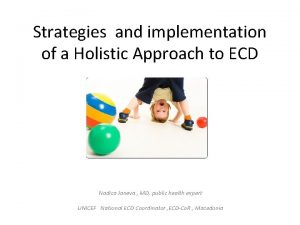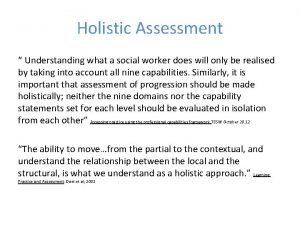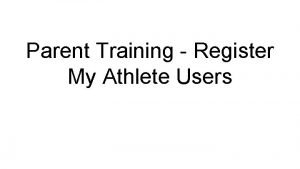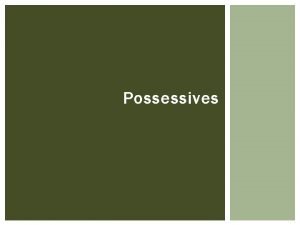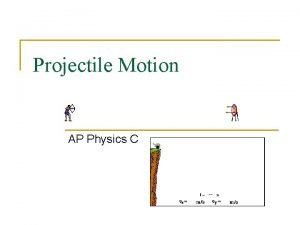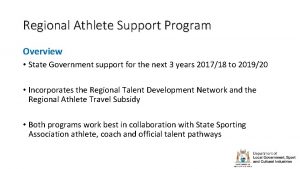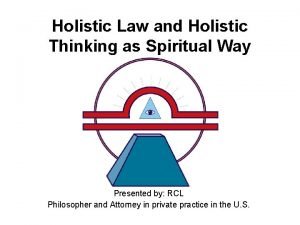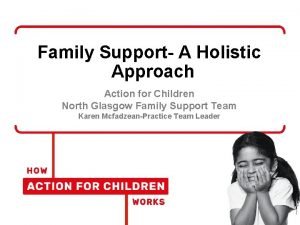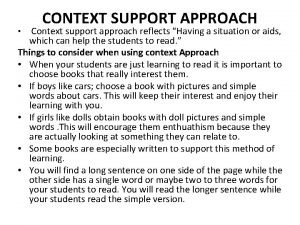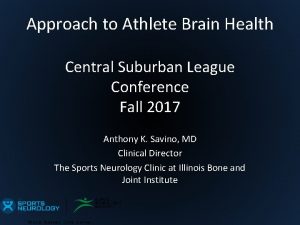Support for the Athlete A Holistic Approach to

















- Slides: 17

Support for the Athlete: A Holistic Approach to Understanding Injury and Promoting Positive Transitions Jenna Rosen, Psy. D Clinical Psychologist Professional Athlete Care Team (PACT) Tulane University School of Medicine

Why It Matters In the U. S. , approximately 10 million individuals, including 3. 5 million children under the age of 14, suffer a sport-related injury each year. There are 460, 000 NCAA Division I student-athletes competing in college athletics per year and only 2% will become professional athletes, thus leaving 98% of elite college athletes transitioning into life beyond competitive athletics and into athletic retirement.

Identity is defined as a “multidimensional view of oneself, including the dimensions and beliefs about oneself that makes one person, or group, different than another” (Merriam-Webster, 2016; Lally, 2007) https: //www. youtube. com/watch? v=JCN 1 XZU 6 je. A&feature=youtu. be

Erikson’s Theory: Identity vs. Role Confusion Identity: Role Confusion: Defining who you are, what Lack of direction and you believe, what you value Commitments to vocation, personal relationships, sexual orientation, ethnic group, ideals Opportunities for exploration or resolution of “identity crisis” or “psychosocial crisis” definition of self Restricted exploration in adolescence Earlier psychosocial conflicts not resolved Society/culture limitations Unprepared for later developmental stages

Identity Foreclosure Committing to one role or specific identity without exploring or investing in alternative roles Have accepted ready-made values and goals that authority figures have chosen for them Tend to be dogmatic, inflexible, intolerant Maladaptive Difficulties with adjustment Stunted developmental maturity Increased risk for personal crisis

Athletic Identity 2008 NCAA survey indicated that the majority of student athletes “view themselves more as athletes than as students” A narrowing of self-identity Can limit the exploration of other developmental roles Prevent investment in development of other roles May lead to identity foreclosure

Athletic Identity Demands of elite sports can hinder athletes’ opportunity to develop important skills, including skills that enable a more mature developmental process and cultivate a well-rounded identity (Lavallee & Robinson, 2007) Athletic identity is highly associated with quality of transition after injury and into life after sports Research shows that retired athletes experience a loss of identity, and those indicating higher athletic identity prior to retirement have a more difficult post-sport transition (Park et al. , 2013)

Sport Injury

Sport Injury Psychosocial and Psychiatric Risk Factors: Andersen and Williams (1988) personal and social factors interact to increase athlete’s risk of injury When athletes enter a potentially stressful situation, such as a key moment in an important competition, the stress response/fight or flight is initiated, which includes the athlete’s: Evaluation (“Do I have the skills to handle this? ”) Physiology (e. g. Heart rate, muscle tension, breathing) Attention (e. g. What the athlete is focusing on)

Sport Injury 4 factors can influence athlete’s stress response & likelihood of injury: 1. Personality Traits: High levels of hardiness, optimism, self-esteem help to buffer athlete from sustaining an injury (e. g. May naturally rely on more effective coping skills; more anxiety may heighten the stress response) 2. Athletes with a greater history of stressful life events, as well as more consistent daily challenges, and/or previous injuries, are more likely to perceive athletic situations as threatening, thus activating the stress response 3. Coping Resources, such as social support and stress management help athletes to effectively manage life stress and decrease risk of injury 4. Mental Skills Training aimed at helping athletes perceive sport stressors as a challenge rather than a threat Stress reduction techniques (deep breathing, muscle relaxation, imagery/visualization)

Sport Injury Psychiatric Risks after Injury: Injured athletes experience clinically significant depression 6 times as often as non-injured athletes (Perna et al. , 1998) Injured athletes are at risk for mental health issues, including depression, PTSD, anxiety, adjustment disorder. About 10% of injured athletes have severe, long-term psychological consequences Athletes who achieve higher levels of success have higher levels of depression and have a higher risk of suicide after injury

Sport Injury How Do Athletes Respond to Injury? Understanding the meaning of an injury to the athlete is crucial to achieving recovery How an athlete responds to an injury depends on his/her personal evaluation of the injury (e. g. confidence that they can recover; perceptions of social support; Wiese-Bjornstal & Shaffer, 1999) This evaluation is strongly influenced by personal (e. g. injury history, motivation) and situational (e. g. level of competition, team dynamics) factors Loss of identity? As discussed earlier, individuals with strong athletic identities are less likely to explore other educational, career, and lifestyle options – may have focused only on his/her sport May feel less emotionally supported if injury results in loss of central role with the team Helping athletes form an identity that is not based solely on sports will help the athlete be more successful in coping with subsequent injuries and life transitions.

Sport Injury and Expression of Pain: Mental health symptoms and psychiatric illnesses are frequently underreported and undertreated in athletes Culture of sport to minimize pain, fear, self-doubt Many athletes feel acute pressure to play through psychological and physical pain – Survey of NCAA Division I athletes found that 70% reported having been injured at least once, and more than half felt pressure to play while injured (Nixon, 1996) It takes courage to be honest with ourselves and others about how we feel. If we can help the athletes we work with to start to acknowledge these feelings, they will be more successful in overcoming fear, decreasing their risk for injury, and improving the quality of their transitions.

Mental Skills Training Coping skills development is a fundamental therapeutic skill-set to overcome life stressors (Hood & Carruthers, 2002) Athletes often use sport as a primary coping tool for life stressors Injury removes this outlet, which leaves the athlete more vulnerable to emotional distress Difficult life issues, such as avoided losses, relationship challenges, insecurities, etc. may come to the surface when primary coping skill is lost and without the support of the athletic “family” Need to develop additional and alternative coping strategies and social supports “back up” stress relievers

Mental Skills Training Camp for the Brain There are tools and techniques you can use to help yourself cope with stress and fear, even in the toughest of situations. 1. Goal Setting – make sure they are SMART (Specific, Measurable, Attainable, Realistic, Time-bound) – helpful in rehab compliance/effectiveness; ownership and involves them in process of charting progress 2. Imagery – can use imagery to “see” themselves successfully returning to competition, practice “mental reps” of sport skill, visualize the healing process, a successful transition 3. Relaxation – by learning to control breathing and muscular activation through different techniques, they can naturally relieve pain, improve sleep, decrease heart rate, blood pressure, and muscle tension, enhance learning and skill development, and an increase capacity for focused attention.

Mental Skills Training If it works for the Navy SEALs…. . https: //gearpatrol. com/2017/02/02/box-breathing-navyseals/

Preparing for Positive Transitions Life transitions and foreseeable changes are characterized as major risk factors to the development of mental health symptoms including depression, anxiety and even suicidality (Silverman, 2014) It is essential to understand the importance of sports in the athlete’s life Athletes may form an identity based on participation in sports, and disruptions to this lifestyle can result in depression, anxiety, stress disorders, etc. Helping athletes find other outlets to replace athletics may reduce emotional distress and improve the quality of their transition Athletes with depressive symptoms may be more likely to follow through with psychotherapy than medication. Studies have shown that when a life development intervention is used prior to athletic retirement, athletes experience a more positive transition process – enhancing coping skills and limiting psychological impact, mental health symptoms, and potential suicidality (Lavallee, 2005).
 Holistic student support
Holistic student support Holistic approach
Holistic approach Holistic approach in early childhood education
Holistic approach in early childhood education Qualitative research is viewed in a holistic perspective.
Qualitative research is viewed in a holistic perspective. Holistic approach social work
Holistic approach social work Olympic background images
Olympic background images Register my athlete login
Register my athlete login Sports marketing jobs
Sports marketing jobs Athlete possessive form
Athlete possessive form Athlete pushes bar upward reaction
Athlete pushes bar upward reaction An athlete throws a javelin to a maximum distance of 80m
An athlete throws a javelin to a maximum distance of 80m Athlete's circle of care
Athlete's circle of care Venn diagram of communicable and non-communicable diseases
Venn diagram of communicable and non-communicable diseases Pulse rate group
Pulse rate group Disappoint suffixes
Disappoint suffixes Pele greatest athlete of all time
Pele greatest athlete of all time My favorite athlete is
My favorite athlete is Athlete plural possessive
Athlete plural possessive


